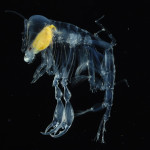Check out this incredible video of jellyfishing (aka ‘jellyballing’). The first part of the video, with the brown-colored jellyfish, is from the US state of Georgia, where jellyfishing is one of the state’s largest fisheries. The second part of the video, with the blue jellyfish, is from the Gulf of California, Mexico. And the third video, with the man and the net…well I’m not actually sure where that’s from. Possibly South America.
In all three cases the species being harvested is supposedly the ‘cannonball jellyfish’ Stomolophus meleagris. However, recent work done scientist Dr. Liza Gómez Daglio is shaking this idea up a bit: using DNA, she discovered there are at least six undescribed species of cannonball jelly, possibly more (paper).
We don’t actually know the species boundaries for all these different cannonball jellies, so it’s hard to say if some species are being fished more than others. Though the blue ones vs brown ones are clearly very different.
Regardless of species or color, nearly all of the jellyfish caught in the US are shipped overseas to Asian markets, where people enjoy jellyfish in a variety of different dishes. Personally, I find jellyfish to be a bit like eating chicken cartilage crossed with rubber bands. While it may be an acquired taste, clearly many people have it: a recent paper reports that “Japan has imported 5400–10000 tons of jellyfish products per year, valued at about 25.5 million US dollars, annually from the Philippines, Vietnam, Thailand, Malaysia, Indonesia, Singapore and Myanmar” (paper).
Thousands of tons of jellyfish is a lot by any measure. But how many tons of jelly are caught in the Americas is harder to say. Scientists have no idea what impact, if any, jellyfishing has on jelly populations here in the US, particularly for undescribed cannonball species. In China, fisheries experts bump up the jelly population by ‘seeding’ wild jelly stocks with hundreds of millions of baby jellies each year. That’s right: China actually adds hundreds of millions of jellyfish to their coastal waters annually. Good jelly harvesting and culturing practices may help make their jellyfishery sustainable over the long term, while feeding demand for these crunchy, rubber band-esq invertebrates. With more information on the US cannonball species, perhaps we could develop similar conservation measures to help preserve and protect our local species, while also supporting local fisherman.
Regardless of how we protect our local species, I doubt jellyfish will become a popular snack here in the US anytime soon. While I’d love to catch jellyfish by the boatload, when it comes to eating jellyfish, my personal favorite is still the Swedish kind.








Jellyfish, like a lot of seafood, is nothing without it’s sauces. A bit of sesame oil and salt goes far.
Thanks! I think you would like it!
Interesting, and impressive video, thanks RR! I think the third part of the video is also in Mexico (a boat has a Mexican flag).. Perhaps also in the Gulf of California…
Great observation! The jellies look more like the kind found in the Gulf of Mexico (brown) than in the Gulf of California (blue). Maybe they’re fished on both sides of Mexico?? Thanks for pointing this out!
Over the last few months, there have been tens of thousands of Jellyfish in the water. I mostly see them in the top 2m of the water column and it seems that most of them are around deep areas of water in pittwater and mostly just in the main channel and not in most bays. I have not seen any schools of fish on the surface inside these masses of Jellyfish and have not caught any fish in them and i was just wondering, do the pelagic fish stay away from these jellyfish or do they just stay down deeper, is fishing on the bottom affected by this? and also what you should be doing in these situations.
Many of the regions where jellyfish populations appear to be increasing are heavily fished or overfished.